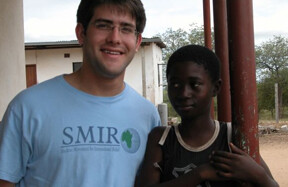I founded the Student Movement for Real Change (SMRC) in Denver, Colorado, in 2001 after a coffee-table conversation with two of my friends. We were discussing the state of education in our home state and the nation overall. In that year, Colorado ranked in the bottom half of high-school graduation rates nationwide.
"We can do something! We have to do something," I said. The lack of student voices in the shaping of public policy and the national agenda had been viewed as a fait accompli. But after reading that day’s inadequate local news coverage, we were not willing to accept that fate.
"Let’s create a magazine—we’ll call it The Real Deal," my lifelong friend Micah Friedman said.
"That’s perfect," I replied. "Let’s be a student movement for real change."
With that, the idea for the organization was born. Today, the Student Movement for Real Change has grown to be a national organization endorsed by Nelson Mandela with an esteemed Board of Advisors including ambassadors, academics, and business leaders.
I visited the Limpopo province of South Africa in spring 2002 during a family vacation. There I met African students studying outdoors. The lack of supplies, classrooms, and resources struck me, and I vowed that through the Student Movement young leaders in the United States would build three classrooms for the children. Returning to the United States, the goal was clear. And students—all in high school at that point—got behind the idea. By hosting car washes and bake sales, by sending mailings and cosponsoring events, the Student Movement raised the initial money to build the needed classrooms. That money was matched by a generous philanthropist in South Africa.
The first college chapter of the Student Movement was founded in 2002 at Johns Hopkins University when I began there as a college freshman. That year the chapter raised $10,000 for the project. Working closely with partner organizations, particularly the Buffelshoek Trust in South Africa, I was able to connect students in the United States with projects abroad. Yet I believed it was time for more students to advocate for African education and learn firsthand about the plight of their peers abroad.
Five Hopkins students and I visited South Africa, and concluded our trip at Mashlati. After the tour of the classrooms that SMRC had built, I sat down with a teacher and asked her what her wildest dream for her classroom was.
"Wildest dream?" she asked with a contagious smile.
"Anything, yes, anything," I said.
She looked at me, confounded, and replied, "If it could be anything, I would want furniture."
"We’ll get that for you," I replied immediately.
Upon their return to the United States, the students who had traveled with me expanded the Student Movement by inviting young leaders to establish chapters at their colleges. In 2003, I developed a leadership operations package that was distributed to students nationally, and Student Movement chapters were soon founded in California, Washington, D.C., and Colorado.
Nelson Mandela spoke in 2003 to the Johns Hopkins campus via satellite teleconference: "My faith in the people of the United States to act in the interest of a better life for all the people in the world is vindicated by people like yourself in the Student Movement."
I recall a life-changing telephone conversation this past spring with Lily Muldoon, SMRC’s Project Director for the Kenya Water Project.
"The water catchments we wanted to use here will not work. We need to build a proper pipeline. However, it isn’t going to cost $15,000. It will cost $600,000," she said on the phone from Kenya.
That was far more money than the Student Movement had ever raised or pledged. I told her the Student Movement was up to the task and would meet the pledge. Her voice relaxed and we began to strategize. From that plan, students at more than a dozen campuses nationwide raised $25,000 in just two months, and they now have an awareness of the water shortage in Kenya.
The model of the Student Movement is to engage students on pressing global issues that aren’t represented in the mainstream media. Today, the Student Movement has nearly two dozen college campuses that are actively engaged in raising awareness and funds for issues in neglected regions of the world.
Students fundraise for schools in the Limpopo province in rural South Africa, for a water-pipeline in rural Kenya, and coordinate the Joining Hands Pen-Pals project. The Student Movement has been recognized in several campus newspapers and most recently in the Washington Post for its work on student leadership and international development.
Through Student Movement, students are driving development, leading on issues that rarely attract international attention, and becoming the informed leaders that will be necessary for international peace. The students find that their priorities shift as they become aware of genocide, civil war, disease, water sanitation, hunger, lack of education, and other issues that plague the developing world. For these students, their work has just begun. In the meantime, the Student Movement for Real Change is empowering students to become leaders, giving them opportunities to improve health and education in developing communities worldwide.




